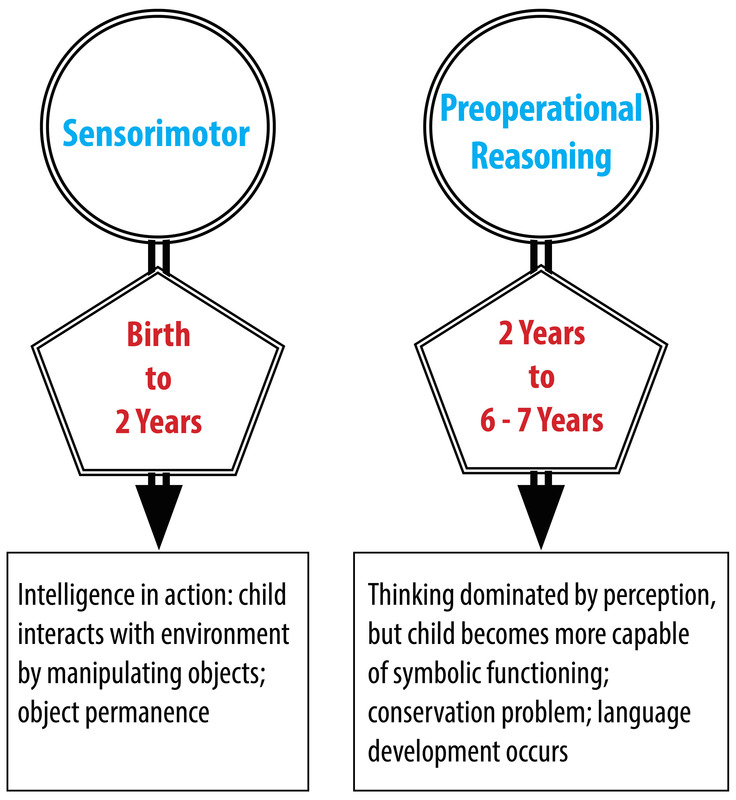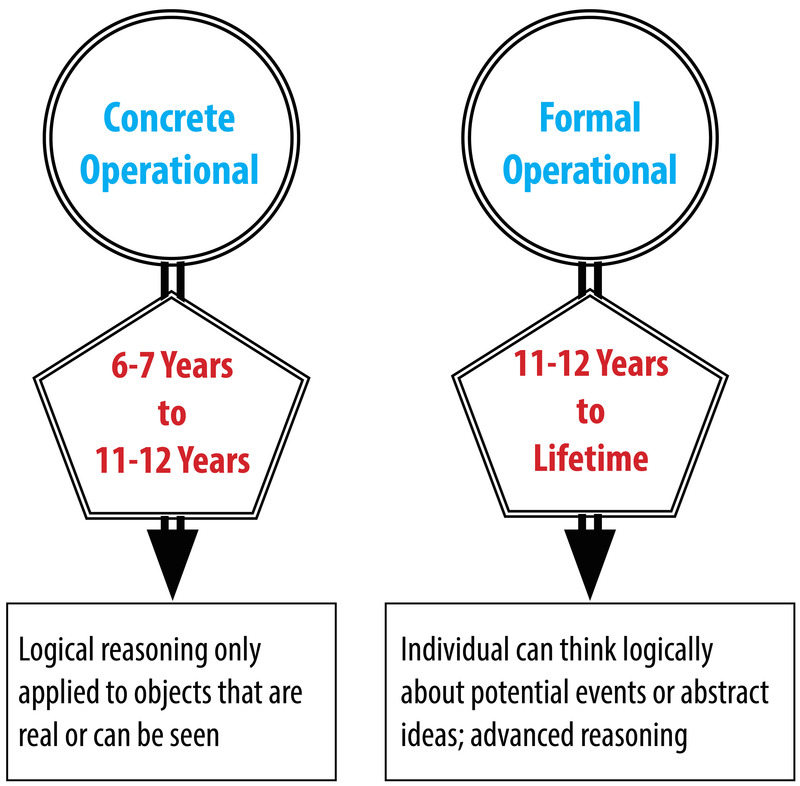8.3 Does Cognitive Development Progress Through Distinct Stages?
Some aspects of the development of living organisms, such as the growth of the width of a pine tree, involve quantitative changes, with the tree getting a little wider each year. Other changes, such as the life cycle of a ladybug, involve qualitative changes, with the creature becoming a totally different type of entity after a transition than before (Figure 8.3). The existence of both gradual, quantitative changes and relatively sudden, qualitative changes in the world has led researchers who study cognitive development to ask whether changes in children’s thinking are gradual and continuous or sudden and discontinuous.

The great Swiss psychologist Jean Piaget proposed that children’s thinking progresses through a series of four discrete stages. By “stages,” he meant periods during which children reasoned similarly about many superficially different problems, with the stages occurring in a fixed order and the thinking within different stages differing in fundamental ways. The four stages that Piaget hypothesized were the sensorimotor stage (birth to 2 years), the preoperational reasoning stage (2 to 6 or 7 years), the concrete operational reasoning stage (6 or 7 to 11 or 12 years), and the formal operational reasoning stage (11 or 12 years and throughout the rest of life).
During the sensorimotor stage, children’s thinking is largely realized through their perceptions of the world and their physical interactions with it. Their mental representations are very limited. Consider Piaget’s object permanence task, which is one of his most famous problems. If an infant younger than 9 months of age is playing with a favorite toy, and another person removes the toy from view, for example by putting it under an opaque cover and not letting the infant immediately reach for it, the infant is very likely to make no effort to retrieve it and to show no emotional distress (Piaget, 1954). This is not due to their being uninterested in the toy or unable to reach for it; if the same toy is put under a clear cover, infants below 9 months readily retrieve it (Munakata, McClelland, Johnson, & Siegler, 1997). Instead, Piaget claimed that infants less than 9 months do not understand that objects continue to exist even when out of sight.
During the preoperational stage, according to Piaget, children can solve not only this simple problem (which they actually can solve after 9 months) but show a wide variety of other symbolic-representation capabilities, such as those involved in drawing and using language. However, such 2- to 7-year-olds tend to focus on a single dimension, even when solving problems would require them to consider multiple dimensions. This is evident in Piaget’s (1952) conservation problems. For example, if a glass of water is poured into a taller, thinner glass, children below age 7 generally say that there now is more water than before. Similarly, if a clay ball is reshaped into a long, thin sausage, they claim that there is now more clay, and if a row of coins is spread out, they claim that there are now more coins. In all cases, the children are focusing on one dimension, while ignoring the changes in other dimensions (for example, the greater width of the glass and the clay ball).

Long Description
Description of the image
Title: Piaget’s Sensorimotor and Pre-operational Reasoning Stages.
2 flowcharts. On the left:
- Sensorimotor
- Birth to 2 Years
- Intelligence in action; child interacts with environment by manipulating objects; object permanence
On the right:
- Preoperational Reasoning
- 2 Years to 6-7 Years
- Thinking dominated by perception, but child becomes more capable of symbolic functioning; conservation problem; language development occurs
Children overcome this tendency to focus on a single dimension during the concrete operations stage, and think logically in most situations. However, according to Piaget, they still cannot think in systematic scientific ways, even when such thinking would be useful. Thus, if asked to find out which variables influence the period that a pendulum takes to complete its arc, and given weights that they can attach to strings in order to do experiments with the pendulum to find out, most children younger than age 12, perform biased experiments from which no conclusion can be drawn, and then conclude that whatever they originally believed is correct. For example, if a boy believed that weight was the only variable that mattered, he might put the heaviest weight on the shortest string and push it the hardest, and then conclude that just as he thought, weight is the only variable that matters (Inhelder & Piaget, 1958).
Finally, in the formal operations period, children attain the reasoning power of mature adults, which allows them to solve the pendulum problem and a wide range of other problems. However, this formal operations stage tends not to occur without exposure to formal education in scientific reasoning, and appears to be largely or formal operations stage completely absent from some societies that do not provide this type of education.
Although Piaget’s theory has been very influential, it has not gone unchallenged. Many more recent researchers have obtained findings indicating that cognitive development is considerably more continuous than Piaget claimed. For example, Diamond (1985) found that on the object permanence task described above, infants show earlier knowledge if the waiting period is shorter. At age 6 months, they retrieve the hidden object if the wait is no longer than 2 seconds; at 7 months, they retrieve it if the wait is no longer than 4 seconds; and so on. Even earlier, at 3 or 4 months, infants show surprise in the form of longer looking times if objects suddenly appear to vanish with no obvious cause (Baillargeon, 1987). Similarly, children’s specific experiences can greatly influence when developmental changes occur. Children of pottery makers in Mexican villages, for example, know that reshaping clay does not change the amount of clay at much younger ages than children who do not have similar experiences (Price-Williams, Gordon, & Ramirez, 1969).

Long Description
Description of the image
Title: Piaget’s Concrete and Formal Operations Stages.
2 flowcharts. On the left:
- Concrete Operational
- 6-7 Years to 11-12 Years
- Logical reasoning only applied to objects that are real or can be seen
On the right:
- Formal Operational
- 11-12 Years to Lifetime
- Individual can think logically about potential events or abstract ideas; advanced reasoning
So, is cognitive development fundamentally continuous or fundamentally discontinuous? A reasonable answer seems to be, “It depends on how you look at it and how often you look.” For example, under relatively facilitative circumstances, infants show early forms of object permanence by 3 or 4 months, and they gradually extend the range of times for which they can remember hidden objects as they grow older. However, on Piaget’s original object permanence task, infants do quite quickly change toward the end of their first year from not reaching for hidden toys to reaching for them, even after they’ve experienced a substantial delay before being allowed to reach. Thus, the debate between those who emphasize discontinuous, stage-like changes in cognitive development and those who emphasize gradual continuous changes remains a lively one.
Large, fundamental change, as when a caterpillar changes into a butterfly; stage theories such as Piaget’s posit that each stage reflects qualitative change relative to previous stages.
Large, fundamental change, as when a caterpillar changes into a butterfly; stage theories such as Piaget’s posit that each stage reflects qualitative change relative to previous stages.
Ways in which development occurs in a gradual incremental manner, rather than through sudden jumps.
Piagetian stage between ages 7 and 12 when children can think logically about concrete situations but not engage in systematic scientific reasoning.
Piagetian stage starting at age 12 years and continuing for the rest of life, in which adolescents may gain the reasoning powers of educated adults.
